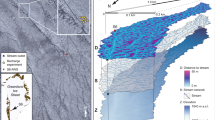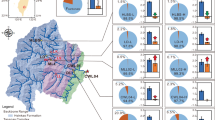Abstract
Roughly six petagrams of organic carbon are stored within ice worldwide. This organic carbon is thought to be of old age and highly bioavailable. Along with storage of ancient and new atmospherically deposited organic carbon, microorganisms may contribute substantially to the glacial organic carbon pool. Models of glacial microbial carbon cycling vary from net respiration to net carbon fixation. Supraglacial streams have not been considered in models although they are amongst the largest ecosystems on most glaciers and are inhabited by diverse microbial communities. Here we investigate the biogeochemical sequence of organic carbon production and uptake in an Antarctic supraglacial stream in the McMurdo Dry Valleys using nanometre-scale secondary ion mass spectrometry, fluorescence spectroscopy, stable isotope analysis and incubation experiments. We find that heterotrophic production relies on highly labile organic carbon freshly derived from photosynthetic bacteria rather than legacy organic carbon. Exudates from primary production were utilized by heterotrophs within 24 h, and supported bacterial growth demands. The tight coupling of microbially released organic carbon and rapid uptake by heterotrophs suggests a dynamic local carbon cycle. Moreover, as temperatures increase there is the potential for positive feedback between glacial melt and microbial transformations of organic carbon.
This is a preview of subscription content, access via your institution
Access options
Access Nature and 54 other Nature Portfolio journals
Get Nature+, our best-value online-access subscription
$29.99 / 30 days
cancel any time
Subscribe to this journal
Receive 12 print issues and online access
$259.00 per year
only $21.58 per issue
Buy this article
- Purchase on Springer Link
- Instant access to full article PDF
Prices may be subject to local taxes which are calculated during checkout


Similar content being viewed by others
References
Hood, E. et al. Glaciers as a source of ancient and labile organic matter to the marine environment. Nat. Geosci. 462, 1044–1047 (2009).
Stubbins, A. et al. Anthropogenic aerosols as a source of ancient dissolved organic matter in glaciers. Nat. Geosci. 5, 198–201 (2012).
Singer, G. A. et al. Biogeochemically diverse organic matter in Alpine glaciers and its downstream fate. Nat. Geosci. 5, 710–714 (2012).
Bhatia, M. P. et al. Organic carbon export from the Greenland ice sheet. Geochim. Cosmochim. Acta 109, 329–344 (2013).
Antony, R. et al. Origin and sources of dissolved organic matter in snow on the East Antarctic ice sheet. Environ. Sci. Technol. 48, 6151–6159 (2014).
Smith, H. J. et al. Biofilms on glacial surfaces: hotspots for biological activity. NPJ Biofilms Microbiomes 2, 16008 (2016).
Cook, J., Edwards, A., Takeuchi, N. & Irvine-Fynn, T. Cryoconite: the dark biological secret of the cryosphere. Prog. Phys. Geogr. 40, 66–111 (2016).
Anesio, A. M., Hodson, A. J. & Fritz, A. High microbial activity on glaciers: importance to the global carbon cycle. Glob. Change Biol. 15, 955–960 (2009).
Li, F., Ginoux, P. & Ramaswamy, V. Distribution, transport, and deposition of mineral dust in the Southern Ocean and Antarctica: contribution of major sources. J. Geophys. Res. 113 (2008).
Bauer, S. E. et al. Historical and future black carbon deposition on the three ice caps: ice core measurements and model simulations from 1850 to 2100. J. Geophys. Res. 118, 7948–7961 (2013).
Stibal, M., Sabacka, M. & Zarsky, J. Biological processes on glacier and ice sheet surfaces. Nat. Geosci. 5, 771–774 (2012).
Sanclements, M. D. et al. Biogeophysical properties of an expansive Antarctic supraglacial stream. Ant. Sci. 29, 33–44 (2017).
Foreman, C. M. et al. Microbial growth under humic-free conditions in a supraglacial stream system on the Cotton Glacier, Antarctica. Environ. Res. Lett. 8, 035022 (2013).
Barker, J. D., Dubnick, A., Lyons, W. B. & Chin, Y. P. Changes in dissolved organic matter (DOM) fluorescence in proglacial Antarctic streams. Arct. Ant. Alp. Res. 45, 305–317 (2013).
Ogawa, H., Amagai, Y., Koike, I., Kaiser, K. & Benner, R. Production of refractory dissolved organic matter by bacteria. Science 292, 917–920 (2001).
Teira, E., Pazó, M. J. & Serret, P. Dissolved organic carbon production by microbial populations in the Atlantic Ocean. Limnol. Oceanogr. 46, 1370–1377 (2001).
Coveney, M. F. Bacterial uptake of photosynthetic carbon from freshwater phytoplankton. Oikos 38, 8–20 (1982).
Van den Meersche, K. & Middelburg, J. J. Carbon-nitrogen coupling and algal-bacterial interactions during an experimental bloom: modeling a 13C tracer experiment. Limnol. Oceanogr. 49, 862–878 (2004).
Takacs, C. D., Priscu, J. C. & McKnight, D. M. Bacterial dissolved organic carbon demand in McMurdo Dry Valley lakes, Antarctica. Limnol. Oceanogr. 46, 1189–1194 (2001).
Suttle, C. A. Marine viruses—major players in the global ecosystem. Nat. Rev. Microbiol. 5, 801–812 (2007).
Säwström, C., Lisle, J., Anesio, A. M., Priscu, J. C. & Laybourn-Parry, J. Bacteriophage in polar inland waters. Extremophiles 12, 167–175 (2008).
Wigington, C. H. Re-examination of the relationship between marine virus and microbial cell abundances. Nature 1, 15024 (2016).
Säwström, C., Anesio, M. A., Granéli, W. & Laybourn-Parry, J. Seasonal viral loop dynamics in two large ultraoligotrophic Antarctic freshwater lakes. Microb. Ecol. 53, 1–11 (2007).
Boetius, A., Anesio, A. M., Deming, J. W., Mikucki, J. A. & Rapp, J. Z. Microbial ecology of the cryosphere: sea ice and glacial habitats. Nat. Rev. Microbiol. (2015).
Musat, N. et al. The effect of FISH and CARD-FISH on the isotopic composition of 13C- and 15N-labeled Pseudomonas putida cells measured by nanoSIMS. Syst. Appl. Microbiol. 37, 267–276 (2014).
Langley, E. S., Leeson, A. A., Stokes, C. R. & Jamieson, S. S. R. Seasonal evolution of supraglacial lakes on an East Antarctic outlet glacier. Sci. Invest. Rep. 43, 8563–8571 (2016).
Priscu, J. C. & Christner, B. C. Microbial Diversity and Bioprospecting (ed. Bull, A.) (ASM Press, 2004).
Kohler, T. J. et al. Life in the main channel: long-term hydrologic control of microbial mat abundance in McMurdo Dry Valley streams, Antarctica. Ecosystems 18, 310–327 (2015).
Hood, E., Battin, T. J., Fellman, J., O’Neel, S. & Spencer, R. G. M. Storage and release of organic carbon from glaciers and ice sheets. Nat. Geosci. 8, 91–96 (2015).
Kuipers Munneke, P., Picard, G., Broeke den, M. R., Lenaerts, J. T. M. & Meijgaard, E. Insignificant change in Antarctic snowmelt volume since 1979. Sci. Invest. Rep. 39 (2012).
Hodson, A. et al. The cryoconite ecosystem on the Greenland ice sheet. Ann. Glaciol. 51, 123–129 (2010).
Kirchman, D., K’nees, E. & Hodson, R. Leucine incorporation and its potential as a measure of protein synthesis by bacteria in natural aquatic systems. Appl. Environ. Microbiol. 49, 599–607 (1985).
Lizotte, M. P., Sharp, T. R. & Priscu, J. C. Phytoplankton dynamics in the stratified water column of Lake Bonney, Antarctica. Polar Biol. 16, 155–162 (1996).
Vick, T. J. & Priscu, J. C. Bacterioplankton productivity in lakes of the Taylor Valley, Antarctica, during the polar night transition. Aquat. Microb. Ecol. 68, 77–90 (2012).
Musat, N. et al. A single-cell view on the ecophysiology of anaerobic phototrophic bacteria. Proc. Natl Acad. Sci. USA 105, 17861–17866 (2008).
Pernthaler, A. et al. Sensitive multi-color fluorescence in situ hybridization for the identification of environmental microorganisms. Mol. Microb. Ecol. Manual 2, 711–725 (2004).
Pernthaler, A., Pernthaler, J. & Amann, R. Fluorescence in situ hybridization and catalyzed reporter deposition for the identification of marine bacteria. Appl. Environ. Microbiol. 68, 3094–3101 (2002).
Polerecky, L. Look@NanoSIMS–a tool for the analysis of nanoSIMS data in environmental microbiology. Environ. Microbiol. 14, 1009–1023 (2012).
Foster, R. A. et al. Nitrogen fixation and transfer in open ocean diatom–cyanobacterial symbioses. ISME J. 5, 1484–1493 (2011).
R Development Core Team R: A Language and Environment for Statistical Computing (R Foundation for Statistical Computing, 2008); http://www.R-project.org
Coble, P. G. Characterization of marine and terrestrial DOM in seawater using excitation-emission matrix spectroscopy. 51, 325–346 (1996).
McKnight, D. M., Boyer, E. W. & Westerhoff, P. K. Spectrofluorometric characterization of dissolved organic matter for indication of precursor organic material and aromaticity. Limnol. Oceanogr. 46, 38–48 (2001).
Brussaard, C. P. D. Optimization of procedures for counting viruses by flow cytometry. Appl. Environ. Microbiol. 70, 1506–1513 (2004).
Acknowledgements
This work was supported by the National Science Foundation Division of Antarctic Sciences through ANT-0838970 and ANT-1141978 to C.M.F., by the NSF Division of Graduate Education through DGE-0654336, and through a NASA Earth and Science Space Fellowship to H.J.S. The Max Plank Society (MPG) supported the nanoSIMS and EA-IRMS analyses. D. Tienken, G. Klockgether, L. Polerecky and G. Lavik from MPI Bremen are acknowledged for assistance in the nanoSIMS and EA-IRMS analyses. R.A.F. is currently funded by the Knut and Alice Wallenberg Foundation and 13C-DOC measurements were supported by an NSF grant to R.A.F. (BIO-OCE0929015) as well as by the MPG. We thank A. Parker from the Center for Biofilm Engineering at Montana State University for statistical guidance. FlowCAM image analysis was conducted by J. P. Darling at INSTAAR, The University of Colorado. Flow cytometry was performed by D. Dunigan and A. Esmael, University of Nebraska-Lincoln. Any opinions, findings, or conclusions expressed in this material are those of the authors and do not necessarily reflect the views of the National Science Foundation.
Author information
Authors and Affiliations
Contributions
H.J.S., C.M.F. and R.A.F. conceived and designed experiments. H.J.S., C.M.F., S.L. and J.T.L. performed the experiments. H.J.S., C.M.F., R.A.F., S.L., D.M.M. and J.T.L. analysed the data. C.M.F., J.T.L. and M.M.M.K. contributed materials/analysis tools. H.J.S., C.M.F., R.A.F. and D.M.M. wrote the paper.
Corresponding author
Ethics declarations
Competing interests
The authors declare no competing financial interests.
Supplementary information
Supplementary Information
Supplementary Information (PDF 2346 kb)
Rights and permissions
About this article
Cite this article
Smith, H., Foster, R., McKnight, D. et al. Microbial formation of labile organic carbon in Antarctic glacial environments. Nature Geosci 10, 356–359 (2017). https://doi.org/10.1038/ngeo2925
Received:
Accepted:
Published:
Issue Date:
DOI: https://doi.org/10.1038/ngeo2925
This article is cited by
-
Potential transformation of organic matter by microbes in cryoconite, Tibetan Plateau
Science China Earth Sciences (2024)
-
A review of physicochemical properties of dissolved organic carbon and its impact over mountain glaciers
Journal of Mountain Science (2024)
-
The evolution of stream dissolved organic matter composition following glacier retreat in coastal watersheds of southeast Alaska
Biogeochemistry (2023)
-
How humans alter dissolved organic matter composition in freshwater: relevance for the Earth’s biogeochemistry
Biogeochemistry (2021)
-
Biochemical evolution of dissolved organic matter during snow metamorphism across the ablation season for a glacier on the central Tibetan Plateau
Scientific Reports (2020)



